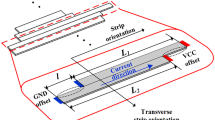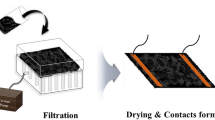Abstract
Developing new heating techniques is crucial for manufacturing carbon fiber-reinforced polymer (CFRP) composite parts, as these kinds of components usually need to be chemically cured or physically consolidated under specific temperature fields. Recently, great attention has been paid to differentiated heating methods since they can exert a uniform temperature field on the component and its tooling which always have uneven thermal mass distributions. Moreover, they also offer the possibility of improving the curing or consolidation quality through customized temperature fields. In this paper, we report a differentiated microwave heating method based on pre-designed electromagnetic resonators which has the advantages of wireless connections, quick response, and precise temperature control. To verify the idea, four kinds of resonators with rectangular copper patterns on polyimide films of different thicknesses were first designed and fabricated, making the CFRP laminate have an absorbance of 28%, 47%, 70%, and 81% at different locations. Then, a differentiated heating performance was validated under a fixed microwave power of 1200 W where the temperature of those locations was stabilized at 52.8 °C, 69.1 °C, 86.2 °C, and 93.8 °C, respectively. On this basis, a simulation model with a prediction accuracy of more than 90% was established to model the relationship between the structural parameters of the resonator and the required microwave heating performance. Finally, as a potential application, the proposed method was used to achieve a uniform heating process of a variable-thickness structure. Compared with the overall heating method, the temperature difference was reduced by 82%.
Graphical Abstract















Similar content being viewed by others
References
Robertson I, Yourdkhani M, Centellas P, Aw J, Ivanoff D, Goli E, Lloyd E, Dean L, Sottos N, Geubelle P, Moore J, White S (2018) Rapid energy-efficient manufacturing of polymers and composites via frontal polymerization. Nature 557(7704):223–227. https://doi.org/10.1038/s41586-018-0054-x
Karger-Kocsis J, Mahmood H, Pegoretti A (2020) All-carbon multi-scale and hierarchical fibers and related structural composites: a review. Compos Sci Technol 186:107932. https://doi.org/10.1016/j.compscitech.2019.107932
Mathieu R, Charfi MA, Chatelain JF, Ouellet-Plamondon C, Serra R, Lebrun G (2022) Effect of graphene additive on cutting forces and temperature during the trimming process of CFRP. Int J Adv Manuf Technol 122(9–10):3969–3981. https://doi.org/10.1007/s00170-022-10150-1
Collinson M, Bower M, Swait T, Atkins C, Hayes S, Nuhiji B (2022) Novel composite curing methods for sustainable manufacture: a review. Compos Part C 9:100293. https://doi.org/10.1016/j.jcomc.2022.100293
Abliz D, Duan Y, Steuernagel L, Xie L, Li D, Ziegmann G (2013) Curing methods for advanced polymer composites - a review. Polym Compos 21(6). https://doi.org/10.1177/096739111302100602
Mgbemena CO, Li D, Lin M-F, Liddel PD, Katnam KB, Thakur VK, Nez-had HY (2018) Accelerated microwave curing of fibre-reinforced thermoset polymer composites for structural applications: a review of scientific chall-enges. Compos Part A Appl Sci Manuf 115:88–103. https://doi.org/10.1016/j.compositesa.2018.09.012
https://www.compositesworld.com/news/toray-announces-new-out-of-autoclave-cfrp-technology. Accessed Aug 2023
Matsuzaki R, Yokoyama R, Kobara T, Tachikawa T (2019) Multi-objective curing optimization of carbon fiber composite materials using data assimila-tion and localized heating. Compo Part A 119:61–72. https://doi.org/10.1016/j.compositesa.2019.01.021
Hou J, You B, Xu J, Wang T (2022) Prediction of curing process for thermosetting prepreg compression molding process based on machine learning. Polym Compos 43(3):1749–1762. https://doi.org/10.1002/pc.26494
Shen Y, Lu Y, Liu S, Liu Q, Tao S, Hao X (2022) Self-resistance electric heating of shaped CFRP laminates: temperature distribution optimization and validation. Int J Adv Manuf Technol 121(3–4):1755–1768. https://doi.org/10.1007/s00170-022-09153-9
Liu S, Li Y, Gan J, Yang Z, Zhou J, Hao X (2023) Active control of c-ure-induced distortion for composite parts using multi-zoned self-resistance electric heating method. J Manu Processes 93(5):47–59. https://doi.org/10.1016/j.jmapro.2023.02.037
Shi B, Shang Y, Zhang P, Cuadros A, Qu J, Sun B, Gu B, Chou T, Fu K (2020) Dynamic capillary-driven additive manufacturing of continuous carbon fiber composite. Matter 2(6):1594–1604. https://doi.org/10.1016/j.matt.2020.04.010
Halford B (2015) Zone control of tool temperature. US 9,034,234 B2
Matsen M, Seattle, Negley M, Bellevue, Peterson K, Bellevue (2011) Method and apparatus for curing a composite part layup. US 2011/0229720 A1
https://www.compositesworld.com/articles/update-lower-wing-skin-wing-of-tomorrow. Accessed Aug 2021
Chen J, Wang Y, Liu F, Luo S (2020) Laser-induced graphene paper heaters with multimodally patternable electrothermal performance for low-energy manufacturing of composites. ACS Appl Mater Interfaces 12(20):23284–23297. https://doi.org/10.1021/acsami.0c02188
Kang J, Kim H, Kim KS, Lee S, Bae S, Ahn JH, Kim Y, Choi J, Hong B (2011) High-performance graphene-based transparent flexible heaters. Nano lett 11(12):5154–5158. https://doi.org/10.1021/nl202311v
Lee B, Jeong G (2012) Fabrication of defrost films using graphenes grown by chemical vapor deposition. Cur Appl Phys 12:S113–S117. https://doi.org/10.1016/j.cap.2012.05.012
Liu P, Liu L, Jiang K, Fan S (2011) Carbon-nanotube-film microheater on a polyethylene terephthalate substrate and its application in thermochromic displays. Small 7(6):732–736. https://doi.org/10.1002/smll.201001662
Lee J, Ni X, Daso F, Daso XX, King D, Gómez J, Varela T, Kessler S, Wardle B (2018) Advanced carbon fiber composite out-of-autoclave laminate manufacture via nanostructured out-of-oven conductive curing. Compos Sci and Technol 166:150–159. https://doi.org/10.1016/j.compscitech.2018.02.031
Xiao Z, Sheng C, Xia Y, Yu X, Liang C, Huang H, Gan Y, Zhang J, Zhang W (2019) Electrical heating behavior of flexible thermoplastic polyurethane/Super-P nanoparticle composite films for advanced wearable heaters. J Ind Engr Chem 71:293–300. https://doi.org/10.1016/j.jiec.2018.11.038
Nguyen N, Hao A, Park JG, Liang R (2016) In situ curing and out-of-autoclave of interply carbon fiber/carbon nanotube buckypaper hybrid co-mposites using electrical current. Adv Eng Mater 18(11):1906–1912. https://doi.org/10.1002/adem.201600307
Zhang Q, Yu Y, Yang K, Zhang B, Zhao K, Xiong G, Zhang X (2017) Mechanically robust and electrically conductive graphene-paper/glass-fibers/epoxy composites for stimuli-responsive sensors and Joule heating deicers. Carbon 124:296–307. https://doi.org/10.1016/j.carbon.2017.09.001
Liu S, Li Y, Liu Q, Xu K, Zhou J, Shen Y, Yang Z, Hao X (2021) Th-ermal manipulation in multi-layered anisotropic materials via computed thermal patterning. Adv Funct Mater 32:2109674. https://doi.org/10.1002/adfm.202109674
Menéndez JA, Arenillas A, Fidalgo B, Fernández Y, Zubizarreta L, Calvo E, Bermúdez J (2010) Microwave heating processes involving carbon materials. Fuel Process Technol 91(1):1–8. https://doi.org/10.1016/j.fuproc.2009.08.021
Guan C, Zhan L, Yao S (2022) Finite element simulation and experimental research on uniformity regulation of microwave heating of composite materials. Polymers 14:3484. https://doi.org/10.3390/polym14173484
Yang Y, Fan Z, Hong T, Chen M, Tang X, He J, Chen X, Liu C, Zhu H, Huang K (2020) Design of microwave directional heating system based on phased-array antenna. IEEE Trans Microw Theory Tech 68(11):4896–4904. https://doi.org/10.1109/TMTT.2020.3002831
Anas M, Mustafa MM, Carey DG, Sarmah A, LeMonte J, Green M (2021) Joule heating of carbon pixels for on-demand thermal patterning. Carbon 174:518–523. https://doi.org/10.1016/j.carbon.2020.12.054
Zhou J, Li Y, Zhu Z, Xu E, Li S, Sui S (2022) Microwave heating and curing of metal-like CFRP laminates through ultrathin and flexible resonan-ce structures. Compos Sci Technol 218:109200. https://doi.org/10.1016/j.compscitech.2021.109200
Zhou J, Li Y, Liu S, Zhang Y, Wang P, Sui S (2022) Zone-regulated mi-crowave heating of CFRP laminates via ultrathin and flexible resonance st-ructures with different working frequencies. Comp Comm 29:101016. https://doi.org/10.1016/j.coco.2021.101016
Li D, Zhou J, Li Y, Xue W, Zhu Z, Wen Y (2023) Microwave heating of carbon materials for on-demand thermal patterning via tunable electromagnetic resonators. Carbon 203:865–875. https://doi.org/10.1016/j.carbon.2022.12.024
Zhu Z, Zhou J, Li Y, Qi X, Wang Y, Wen Y (2023) Design of a comp-osite metamaterial toward perfect microwave absorption and excellent load-bearing performance. Mater Des 229:111910. https://doi.org/10.1016/j.matdes.2023.111910
Li Y, Hang X, Li N, Hao X (2016) A temperature distribution prediction model of carbon fiber reinforced composites during microwave cure. J Mater Process Technol 230:280–287. https://doi.org/10.1016/j.jmatprotec.2015.12.001
Niaki S, Haghighat E, Campbell T, Poursartip A, Vaziri R (2021) Physics-informed neural network for modelling the thermochemical curing process of composite-tool systems during manufacture. Comput Methods Appl Mech Engrg 384:113959. https://doi.org/10.1016/j.cma.2021.113959
Gu Y, Xu J, Fu T (2022) Design and optimization of coil structure based on the uniformity of core temperature field. J Mech Sci Technol 36(6):2903–2912. https://doi.org/10.1007/s12206-022-0522-y
Alpay Y, Uygur I, Kilincel M (2020) On the optimum process parameters of infrared curing of carbon fiber-reinforced plastics. Polym Polym Compos 28(6):433–439. https://doi.org/10.1177/0967391119900711
Zhang B, Li Y, Liu S, Shen Y, Hao X (2021) Layered self-resistance electric heating to cure thick carbon fiber reinforced epoxy laminates. Polym Compos 42(5):2469–2483. https://doi.org/10.1002/pc.25992
Funding
This research is supported by the Major Program of the National Natural Science Foundation of China (52090052), the Young Scientists Fund of the National Natural Science Foundation of China (52105364), and the National Natural Science Foundation of China for Distinguished Young Scholars (51925505).
Author information
Authors and Affiliations
Contributions
Yuexian Wang: conceptualization, validation, visualization, investigation, and writing—original draft. Jing Zhou: supervision, methodology, writing—reviewing and editing, project administration, and funding acquisition. Zexin Zhu: supervision and writing—reviewing and editing. Pan Wang: investigation and validation. Xiaozhong Hao: project administration and funding acquisition.
Corresponding author
Ethics declarations
Conflict of interest
The authors declare no competing interests.
Additional information
Publisher's Note
Springer Nature remains neutral with regard to jurisdictional claims in published maps and institutional affiliations.
Rights and permissions
Springer Nature or its licensor (e.g. a society or other partner) holds exclusive rights to this article under a publishing agreement with the author(s) or other rightsholder(s); author self-archiving of the accepted manuscript version of this article is solely governed by the terms of such publishing agreement and applicable law.
About this article
Cite this article
Wang, Y., Zhou, J., Zhu, Z. et al. Differentiated heating of CFRP composite structures wirelessly using microwave and electromagnetic resonators. Int J Adv Manuf Technol 131, 6103–6114 (2024). https://doi.org/10.1007/s00170-024-13356-7
Received:
Accepted:
Published:
Issue Date:
DOI: https://doi.org/10.1007/s00170-024-13356-7




